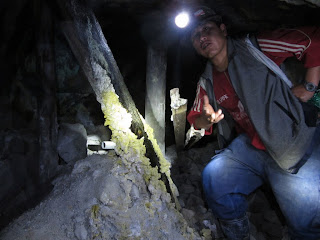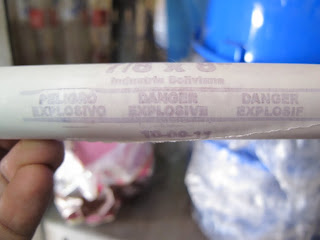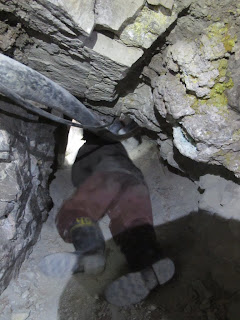 |
| The main church in Potosí |
The town of Potosí and it’s silver mines. Potosí was founded in the mid 16th century when rich ores were discovered in the mountains here. It is said that at 4070m altitude this is the highest city in the world. The Spaniards leapt at the opportunity and started the extraction of Silver. The ores they were extracting were of incredible quality – up to 85% pure silver content. The Spanish empire and it’s vice royalties in South America greatly benefitted from this silver.
When the indigenous could not keep up anymore with the pace set by the colonial powers, African slaves were brought in. In the first three centuries of operation 8 million workers died in those mines. It is said that with the bones of the dead, a bridge could be built from Potosí in Bolivia to Seville in Spain.
It is also said that a similar bridge, this time of pure silver, could be built between here and Spain with all the precious metal that has been extracted from this mountain. Indeed at it’s height, Potosí was very rich and it was one of the biggest cities in the world, bigger than Seville or Paris.
 |
| Our guide Ronald who is himself an ex-miner |
We came to Potosí to do something really crazy: we wanted to visit the mines. Now this is not a museum, nor is there a small gallery which has been "sanitised" for the benefit of the curious tourists. No no no this is a real mine still in activity, brutal and dangerous.
 |
| Ready to go into the mine |
After they made sure we do not have any heart conditions or respiratory problems, they made us sign a waiver that would protect them from any thing that could happen to us down there including death! We signed the paper and were given a miner’s kit, pants, boots and jacket, a helmet and an electric head lamp.
 |
| I'm holding a dynamite stick! |
We boarded the bus and made our way to the mines. We stopped at the miners’ camp where we were supposed to buy some gifts to the miners who would show us around down there. It’s nothing much, we bought fizzy drinks, coca leaves to help relieve the pain … and some dynamite! Yes real dynamite (TNT), a fuse and detonator. The whole package comes in at 20Bs (2€). A cheap alternative to fireworks for new years’ eve ?
With our gifts we headed to one of the Candelaria mine. Only just before entering that we realize what we are doing … this is a real mine, it’s not a zoo or museum, if there is an accident we’re in big trouble. But it’s too late now, no chickening out.
We start by walking 400m along a rail line which carries equipment in and out of the mine. We have to make way for the carts as they pass every now and then. We salute the miners as we go past them. It’s 3pm and they look tired. The first thing that hits you is the darkness, the narrowness of and ruthless environment of this place. Then the sulphur fumes are a constant hassle too, they burn the eyes and the throat. The handkerchief I’m wearing over my nose and mouth is not helping.
 |
| Copper Sulphate Crystals |
We reach the end of this tunnel and go down to level 3 which is about 600m inside the mountain. As we climb down the ladder into that gallery, we immediately feel the difference in temperature. Ronald our guide, who is also an ex-miner tells us that it is only 35°C here. Temperatures in the mines can vary from below freezing to 45°C! Anyway my sweat glands have kicked in and I’m dripping. We continue in the mines and see some beautiful yellow Sulphur precipitations on the wall. There are also some amazing greenish-blue Copper Sulphate crystal and also chocolate brown Zinc ore veins.
 |
| This cart weighs 2 tons |
The dazzle only lasts but a few seconds before the next cart is announced. We make way but this time it’s not pulled by an electric winch. A man, topless emerges from the darkness, he is pulling the cart. I can see the rope burning his skin. Behind the cart two other men are pushing as hard as they can. Ronald tells us that the cart and its content weigh about 2 tons and that as long as the tracks are flat, the guys can move it themselves …
 |
| That's how narrow it is |
We continue the tour and we have to scrape down through a narrow shaft (no more than 50cm diameter at some points) to another lower level. That where I let the bottle of water I was carrying go. It rolls down and gets stuck in a small gallery which is even narrower. I ask the guy in front of me to wait up while I try to go get the bottle, I manage although I can feel the heart rate increasing. I had not seen that there was a hole big enough for a man to fall through. I don’t know how deep it is, maybe 2m maybe 50m – but I don’t want to find out.
After this little extra thrill I catch up with the group and three other miners waiting for another cart to arriveing to load the ore in a rubber basket that will be pulled up by an electric contraption.
 |
| It's hard work loading these baskets |
When the cart arrives, I volunteer to help by shoveling the rocks from the cart to the baskets. After only three minutes I’m panting, sweating and a little bit dizzy. Ronald suggests chewing on some coca leaves. I politely decline preferring water at this point.
After another 500m down, we turn around and start our ascent. The air is almost not breathable and the heat is unbearable. We constantly have to bend forward in order not to bang our heads with the gallery ceiling. Our necks and backs hurt and thighs are burning. There is about 10cm of muddy water at our feet. This place is not for claustrophobes.
 |
| Don Basilio at the back and Ronald on the right conversing |
On our way back up we stop close to a small gallery where a miner is taking a break. We’re lucky because this man, Don Basilio, knows our guide and therefore we get a priviledged interview with him. He speaks Quechua and our guide Ronald is very happy to translate for us. He also encourages us to ask him questions.
So Don Basilio is 42 years old and works in the mines for 26 years. He has 8 children, and his two eldest sons, 17 and 21 also work with him in the mine. I ask him how long he’ll work more and he says maybe another 10 years in order to get a full pension from the cooperative. Another group member asks him whether he likes it at all and you can tell Don Basilio could not quite understand what the question was. He finally answered that there is nothing to like ot dislike but that this is all he knows how to do and that it helps him sustain his family. We thanked Don Basilio and offered him the dynamite for which he was very grateful.
 |
| Roxana is feeling the heat in the mine |
As we were climbing back up Ronald told us about how it all works : most miners work for a cooperative. They pay a 15% tax on whatever they extract to the co-op which itself pays half of that to the state. The miner has to buy his equipment, dynamite, etc himself, those are not supplied by the co-op.
Ronald goes on by telling us that a miner may earn between 1500-3000Bs per month (150-300€) as compared to the 500Bs average salary in the region. They often have big families and the older sons come to work as young as 13. Because they breathe asbestos and silica dust all the time, the life expectancy of miners still today Is between 45 and 55 years! The most common cause of death by illness are lung cancer or Sillicosis, when you start coughing blood and die soon afterwards.
We go back home, back broken, soaked in sweat and dirty. But that’s nothing as compared to what is going on in our heads. We live in a completely different world, we know so little of this one. It does indeed make one ponder …
For more pictures on Potosí
No comments:
Post a Comment